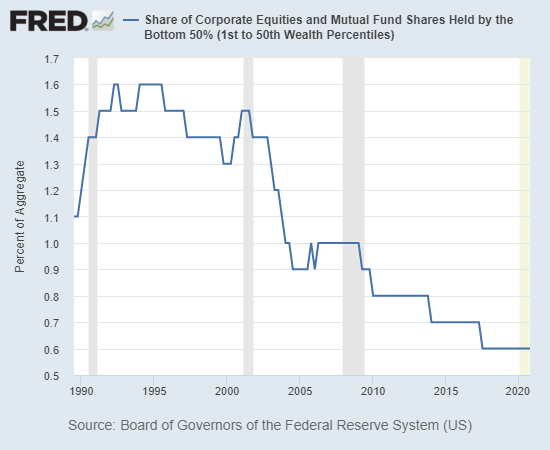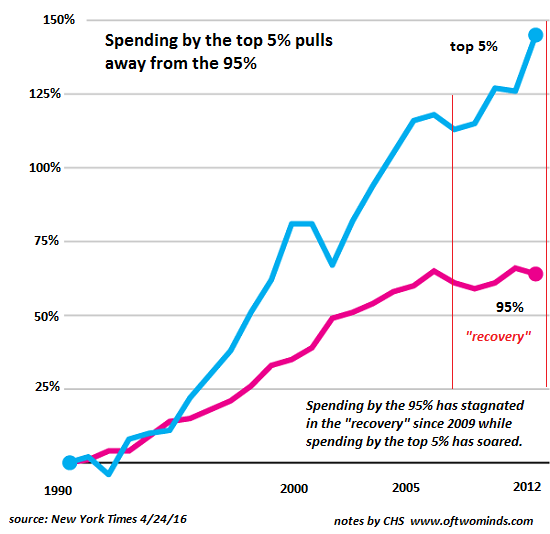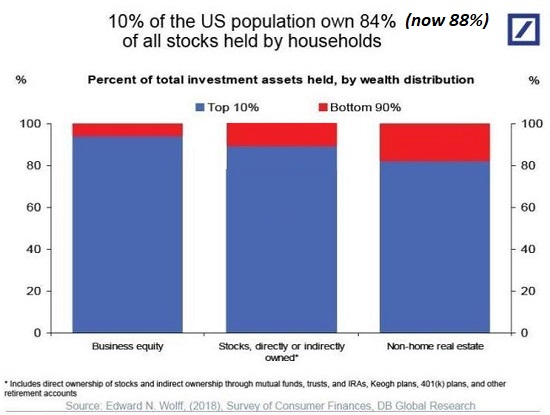
Proceed and become depending on possession bubbles and the totally free spending of the leading 5%, and optimize your economy to serve this “growth,” however be gotten ready for the effects when the expenses of this optimization and dependence come due.
Here’s the problem with focusing the majority of the earnings and wealth in the leading 5%: the whole economy now depends on their spending and “the wealth result” of bubbles driving that spending. As the charts below program, the leading tier of homes own the vast majority of the wealth and take home roughly half of all earnings, including essentially all (97%) the income originated from capital.
By inflating an enormous everything bubble, the Federal Reserve and other central banks have pumped up the “wealth” of this leading tier. This was of course the plan: by synthetically pumping up possession bubbles, the central lenders believed that those seeing their net worth expand would loosen their bag strings and borrow and spend easily: the wealth effect.
The problem with depending on the the wealth impact is that if wealth has actually concentrated in the top, then just the top will benefit. The bottom 50% own essentially no capital (see chart listed below) and the modest wealth owned by the bottom 90% creates a simple 3% of all earnings stemmed from possessions (stocks, bonds, real estate, etc).
Monopoly Versus Democracy: How to End a Gilded Age (foreignaffairs.com):
10 percent of Americans now control 97 percent of all capital earnings in the country. Nearly half of the new income created given that the worldwide monetary crisis of 2008 has gone to the most affluent one percent of U.S. people. The wealthiest 3 Americans jointly have more wealth than the poorest 160 million Americans.
In other words, the Fed has made the rich much, much richer not for being more productive however simply for being abundant to begin with. Trends in earnings and wealth inequality (pewresearch.org):
For the top 5%, it increased by 4%, to $4.8 million. In contrast, the net worth of families in lower tiers of wealth decreased by a minimum of 20% from 2007 to 2016. The greatest loss– 39%– was experienced by the households in the second quintile of wealth, whose wealth fell from $32,100 in 2007 to $19,500 in 2016.
As an outcome, the wealth gap in between America’s richest and poorer families more than doubled from 1989 to 2016. In 1989, the richest 5% of households had 114 times as much wealth as households in the 2nd quintile, $2.3 million compared with $20,300. By 2016, this ratio had increased to 248, a much sharper rise than the expanding gap in income.
Considering that practically all the wealth effect is concentrated in the leading tier, it only impacts the costs of the top tier. Costs by the bottom 95% has stagnated, and so the policy “fix” to this huge inequality created by pumping up property bubbles is to provide money down 90% by means of different “stimulus” programs.
The bottom 90% promptly invested the complimentary money however considering that neither their wealth nor their stagnating earnings increased, the spending boost from this snort of financial cocaine has currently faded.
What occurs when you concentrate half of all earnings and the large majority of all wealth in the leading tier? Your economy end up being totally depending on 1) keeping that property bubble broadening forever and 2) the spending of the leading 5%.
The problem in making your entire economy depending on spending produced by possession bubbles is that all bubbles pop. Oddly enough, printing trillions of dollars, borrowing extra trillions and blowing trillions on stock buybacks have repercussions beyond simply additional inflating asset bubbles, systemic repercussions which ultimately deflate all the bubbles.
The top 5% are now the key to the whole economy. If they start selling possessions to lock in revenues or minimize threat, the property bubbles will pop because the bottom 95% do not have the wealth or income to purchase tens of trillions of possessions from the leading 5%: the leading 5% buy and offer to other 5%-percenters due to the fact that no one else has the income or wealth to purchase 10s of trillions in properties.
If the leading 5% decrease costs for any reason, then the economy craters.
The reasoning can’t be withdrawed by magical thinking:
1. Given that all property bubbles pop, this possession bubble will pop.
2. As soon as this bubble pops, the spending of those seeing their “wealth” lessen will decline.
Considering that the spending of the leading 5% has been the only source of higher usage, the economy has been optimized to serve the top 5%. Hence the expansion of fine-dining dining establishments, costly AirBNB rentals in unique destinations, luxury brand name shops, and so on.
Once the top 5% no longer have the means or desire to spend freely on discretionary purchases, a big swath of the U.S. economy falls into an abyss. And considering that we’ve structured our system to make the abundant richer so they can spend more, there is no substitute source of spending to change the collapse of top 5% spending.
Optimization and reliance have effects. Proceed and end up being depending on property bubbles and the complimentary spending of the leading 5%, and enhance your economy to serve this “development,” however be gotten ready for the consequences when the expenses of this optimization and dependence come due.




My new book is now readily available at a 20 % discount this month: Global Crisis, National Renewal: A(Revolutionary)Grand Strategy for the United States(Kindle$8.95, print$20)If you found value in this content, please join me in looking for solutions by becoming a$1/month patron of my work through patreon.com. Current Videos/Podcasts: Jay Taylor and I go over why Inflation is a Runaway Freight Train(21 minutes)A
Grand Technique to Deal With the Global Crisis(54 min., with Richard Bonugli)XI’s GAMBIT : A Bridge Too Far?(41 minutes, with Gordon Long )My current books:
Worldwide Crisis, National Renewal: A(
Revolutionary) Grand Technique for the United States(Kindle$9.95, print$25)
Drake$1.29 Kindle,$8.95 print); read the very first chapters for free (PDF)Cash and Work Unchained $6.95 Kindle,$15 print)Check out the first area free of charge Become a$1/month patron of my work by means of patreon.com. KEEP IN MIND: Contributions/subscriptions are acknowledged in the order received. Your name and email remain private and will not be given to any other individual, company or company. Thank you, Claus H.($50), for your stupendously generous contribution to this site– I am considerably honored by your support and readership. Thank you, Bobby R. ($ 100), for your insanely
generous contribution to this site– I am considerably honored by your support and readership
. Thank you, Naomi S.($5/month), for your marvelously generous pledge to this site– I am greatly honored by your support and readership. Thank you, Megalanuth ($5/month),

